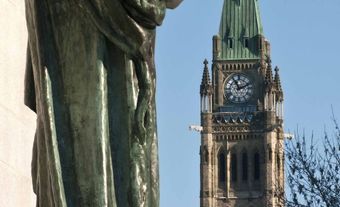Regulatory Process
All levels of government in Canada are involved in regulation. Because many activities in Canada are regulated (eg, airline routes, the types and prices of service provided by telecommunications companies, the number of taxicabs in a municipality and how much they may charge), regulatory systems must be tailored to particular needs. However, certain standard models of regulatory agencies have been widely adopted. In the 1980s there was growing concern over regulatory reform, partly in the form of "deregulation" (though not as thoroughly as in the US) and in proposals and actions that have led to more, or expanded, regulation.
Regulatory Agencies
There are 3 main types of regulatory agency: self-governing bodies, which regulate the conduct of their own members; independent government agencies and boards; and regular line departments headed directly by ministers, which regulate specified industries and activities. Familiar examples of self-governing bodies include the professions, eg, law, medicine and accounting, which are empowered by provincial legislatures to determine their own requirements for admission and to discipline members who do not adhere to prescribed standards of professional conduct.
With self-governing bodies, regulators are drawn from the professions themselves. Government regulatory agency members, on the other hand, are appointed by government. Called commissions (eg, Public Service Commission), boards (eg, NS Board of Public Utility Commissioners) or tribunals (eg, Ontario Commercial Registration Appeal Tribunal), these agencies derive their authority from the legislature, and no regulatory agency has any more authority than that expressly delegated to it by the legislature.
An occupational safety branch of a provincial Department of Labour that decides and enforces employment safety standards is an example of a departmental regulatory agency. Certain agencies may appear more independent than they really are; eg, the FOREIGN INVESTMENT REVIEW AGENCY (FIRA) assessed the benefits of foreign investments but in reality only advised the federal Cabinet, which made the actual decisions. In many fields of public policy (eg, energy, communications) often all 3 types of regulatory agency are in existence.
If the members of an agency are appointed for fixed terms with tenure (unlike other civil servants who may be reassigned at any time) and if the agency has a separate and distinct existence outside of any government department, then it is an independent regulatory agency. A typical agency of this type is the CANADIAN RADIO-TELEVISION AND TELECOMMUNICATIONS COMMISSION (CRTC), which regulates the Canadian broadcasting system and the federal telecommunications carriers. It has its own staff and and is completely separate from the federal Dept of Communications. Although these types of agencies are created by the legislatures and are answerable to them and rely on them for operating funds, they are still, when compared to a branch of a government department, relatively independent. Independence, however, is rarely absolute, in that the Cabinet or a particular minister (or both) may often issue directives to a board and has the power to appoint regulators and approve their budgets.
Policy Formulation and Implementation
Independent regulatory agencies characteristically operate in an open manner, though the degree of openness varies greatly. Their procedures are designed to allow for some degree of public participation. In a typical proceeding a company will apply either for an increase in the rates it charges customers or for a licence for some procedure. Notice of this application will appear in the government's official gazette and possibly in local newspapers so that interested persons may attend a public hearing to state their support or disapproval of the applications. The agency then renders a decision. Such procedures may be appropriate for specific decisions but may not be suitable for determining broader policy issues. Here a somewhat different procedure is often used. Notice is given of a proposed new policy rule and interested persons are invited to comment. There may be an informal public hearing.
Regulators will often discover that they must fill a policy gap. When legislatures create regulatory agencies, they often leave it to the regulator to develop rules that give specific meaning to broad legislative standards. For example, a regulator may be instructed to issue licences for commercial trucking operations where "public necessity and convenience" indicate that licences should be issued. Another regulator may issue airline routes "in the public interest" or allow only "just and reasonable" rates to be charged to telecommunications consumers, phrases so vague that regulators will feel obliged to outline precisely the applicable criteria, which in effect means they are making policy and exercising considerable discretionary power.
Theoretically, in the Canadian system of government, only elected officials make major policy decisions because they alone are politically accountable and may be voted out of office for unpopular policies. But the broad statutory language employed not only allows but in practice requires regulators who are appointed to determine major policies about, eg, trucking and air transportation and telecommunications. Consequently, it is often suggested that the Cabinet be given authority to issue binding policy directives to the independent regulatory agencies. Indeed, in the case of some agencies, this power already exists. This provision often creates dual standards of political accountability that are not always wholly compatible, since one provision ensures greater political accountability through elected ministers whereas the other seeks to provide opportunities for direct public participation in policymaking.
Evaluation of Regulatory Process
Professional self-regulation is usually in the best interests of a profession but not necessarily of the public. Self-regulating bodies need to be continually scrutinized both by the public and by legislatures. The major need in departmental regulation is for increased access, for the public and elected legislators, to precise information. Unless the public has access to information, it cannot hold regulators accountable. Where regulation is by way of an independent agency, it is essential that opportunities for public participation exist and are acted upon; otherwise such agencies tend to be influenced by the industries they are supposed to regulate. The ultimate evaluation of regulatory agencies is not only based on the process used but is also dependent upon the often - indeed usually - conflicting underlying values that govern the purposes that regulation in particular sectors is supposed to serve.

 Share on Facebook
Share on Facebook Share on X
Share on X Share by Email
Share by Email Share on Google Classroom
Share on Google Classroom


